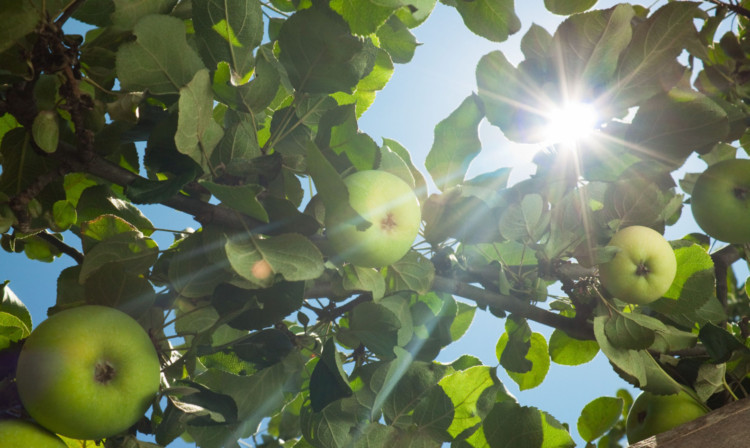This autumn’s glut of apples, plums and brambles is the culmination of perfect weather conditions for fruit growing, discovers Caroline Lindsay.
If you’re lucky enough to have apple and plum trees in your garden, you’ll have noticed the branches groaning under the weight of the fruit this year. But before you give yourself a pat on the back, it’s nothing you’ve done it’s all down to nature.
Experts say that this year’s weather has created the ideal conditions for a bumper crop of sweet and rosy apples. The Royal Horticultural Society (RHS) say last year’s wet autumn followed by the icy spring and a hot summer provided perfect conditions for apple growing in particular.
Jim Arbury, fruit specialist with the RHS, says: “Apples evolved in central Asia to suit a continental climate of hot summers and very cold winters and need to be exposed to a certain amount of cold weather each winter or they won’t flower or fruit properly.”
He explains that the wet autumn in 2012 helped to rule out the chance of drought, which can lead to small, poor-tasting fruit, while chilly conditions right up until April gave the trees enough “chill time” for the fruit to set properly and held back flowering.
By the time they did flower, there were more insects around to pollinate the blossom and less risk of damage by frost. Then, very hot weather in summer boosted ripening, he adds.
Iain Hunter, lecturer in production horticulture at SRUC Elmwood in Cupar, agrees: “It is really thanks to the cold winter and the late, chilly spring,” he says. “Subsequently, the blossom was later and things started happening when conditions were much nicer and not being destroyed by late frosts. As a result, there were more insects to carry out pollination so the whole process gets a big boost.
“But it’s not something you can rely on happening regularly. It’s a cyclical, natural process that typically only occurs once every seven years or so.”
As a result of the bonanza crop there’s going to be a lot of fruit to process and Iain stresses that this takes a lot out of the trees so it’s important to put something back over the winter. “Give your trees a heavy mulch or manure, or recycled green waste, to improve the fertility of the trees.
“Here at Elmwood we have an organic orchard of just under 400 trees. It is only around four or five years old and we have just started experimenting with using the apples for making cider, which is exciting. But we will make sure we give back to the trees over the winter months to prepare them for next year.”
The hedgerows are also laden with fruits just now and it looks like being a bumper year for the brambles. “There’s an interaction between what’s happening in the hedgerows and the orchards,” says Iain. “The same insects that have pollinated the hedgerows then pollinate the fruit trees.”
Ardross Farm Shop, near Elie, is bursting at the seams with tasty cooking apples and Victoria plums at the moment, as manager Nikki Pollock explains. “We grow our own apples but we have also had a lot of fruit from the local community people have been inundated with fruit and they don’t know what to do with it all.
“The weather this year has provided the perfect conditions for a bumper harvest but, let’s face it, anything would be better than last year. This year, though, there was no wind to knock the blossom off so pollination could carry on and we had just the right amount of sun and rain.
“Ardross is a mixed farm so we’re lucky that we have fertiliser from the animal dung to put back in to the trees at the end of the season.”
The Courier’s gardening writer, John Stoa, had a stand at the weekend’s Camperdown Flower and Food Festival and discovered that one topic people discussed with him was the great crops of fruits.
“When you start to analyse patterns and try to come up with some answers, once you have eliminated poor cultural techniques, wrong varieties and poor soil, you are left with climate,” he says.
“I reckon a lot of this year’s harvest is down to effects from last year, then the extended winter and very late spring followed by a brilliant summer.
“The poor weather in 2012 did not help many plants to ripen up young wood necessary to form fruit buds needed the following year, but this varied from one kind to another.
“Critical ones, for me, were my peach and pear trees, with virtually no fruit buds at all, so they were devoid of fruit. Many fruit bushes, such as blackcurrants, saskatoons and strawberries, require cold weather over winter to form fruit buds. They got these last winter, so this summer’s crop has been excessive.
“Apples, cherries and plums require insect pollination at flowering and as the extended winter delayed spring by three to four weeks, there were plenty of flying insects around to assist with the pollination.
“With a record warm, dry summer, is it any surprise that crops have been fantastic?”
